Recently, Ito Teruyuki, the Director General of the South Asia Department of the Japan International Cooperation Agency (JICA), shared insights in an exclusive interview, outlining a strategic roadmap for future collaboration with Bangladesh. Emphasizing three pivotal pillars—diversified industrial development, quality infrastructure, and inclusive development—Teruyuki’s vision underscores the evolving nature of the enduring partnership.
You Can Also Read: Bangladesh Elections Strain USA-Western Relations
Fifty years ago, the roots of JICA’s collaboration with Bangladesh took hold with the dispatch of three volunteers dedicated to agricultural development, a mere two years after the nation’s hard-fought independence. At that critical juncture, Bangladesh faced acute shortages in essentials—rice, meat, clothing, and gasoline—and sought support from Japan amid formidable challenges.
The passage of five decades has witnessed Bangladesh’s extraordinary metamorphosis, marked by economic growth rates consistently exceeding 6% and notable advancements in health and education. Teruyuki aptly characterizes this development as a “miracle” in recent global history.
JICA’s Enduring Legacy in Bangladesh
Throughout this transformative journey, JICA has stood as a steadfast ally, deploying concessional loans, technical cooperation, grant aid, volunteer programs, and more. The cumulative impact exceeds $20 billion in concessional loans, positioning Bangladesh among the top three loan recipient countries. This financial support has materialized into tangible progress—over 100 bridges, large-scale power plants, rural roads, water supply systems in Chattogram and Khulna, Dhaka’s three metro lines, Terminal 3 of Hazrat Shahjalal International Airport, Matarbari deep seaport, and the Bangladesh Special Economic Zone in Araihazar.

Beyond physical infrastructure, JICA has actively contributed to the capacity development of government ministries and agencies, fostering people-to-people exchanges through technical cooperation. Teruyuki underscores the flexibility of JICA’s schemes for Bangladesh, leveraging concessional loans, technical cooperation, volunteers, and various other programs.
What distinguishes Bangladesh in this collaboration is its robust sustainability and bilateral relationship with Japan. Unlike some South Asian and African countries constrained by debt sustainability, Bangladesh stands out as a nation capable of effectively combining and utilizing multiple JICA schemes. In Teruyuki’s words, this resilience and financial flexibility contribute to a unique and robust partnership, adding a climactic note to a narrative of enduring collaboration and shared progress.

From Cyclone Shelters to Carbon Neutrality
In a pivotal statement, he expressed, “We have witnessed significant success and exemplary instances in our collaboration with Bangladesh. The knowledge garnered from this partnership holds the potential for broader applications, not only within Bangladesh but across other nations. The reciprocal exchange of insights and experiences among our recipient countries is a cornerstone of our approach.”
Both Japan and Bangladesh grapple with the challenges of natural disasters, making the exchange of expertise particularly pertinent. With Bangladesh facing unique climatic adversities, including cyclones, storms, and floods, Japan has actively intervened with a comprehensive strategy. The installation of five weather radars across the entire country stands as a testament to Japan’s commitment to mitigating natural disaster damage. Additionally, the construction of 117 high-quality cyclone shelters and 240 km of river embankments underscores the dedication to flood countermeasures, acknowledging the ongoing battle against the impacts of climate change.
In the pursuit of sustainable development, Japan has drafted an integrated energy and power master plan, championing the crucial agenda of carbon neutrality. The narrative of progress is further illuminated by Bangladesh’s commendable economic growth over the past decade, a trajectory anticipated to persist.

Japan’s Three Pillars to Bridge Gaps in Bangladesh
According to Teruyuki, looking ahead, three pillars will anchor the future cooperation between Japan and Bangladesh. The first revolves around industrial development, recognizing the imperative need to diversify Bangladesh’s economy, currently heavily dependent on the readymade garment sector. The collaboration with Jica in establishing the Bangladesh Special Economic Zone at Araihazar exemplifies this commitment, with a hopeful eye on attracting Japanese investment. A focus on human resource development in ICT and manufacturing, coupled with efforts to enhance the business environment through streamlined approval services, is poised to usher in a new era of economic vitality.
The second pillar, quality infrastructure, emphasizes sustainability, economic viability, efficiency in life cycle costs, and conscientious consideration of environmental and social factors. Open and transparent tendering processes underscore the commitment to this vision.
The final pillar, inclusive development, addresses existing disparities between urban and rural areas and among diverse populations. A sustained commitment to education, health, agriculture, and rural development is envisioned to pave the way for a more inclusive society.
In weaving these threads together, the climax emerges not only in the tangible achievements and plans for the future but in the profound commitment to a shared vision of progress, resilience, and inclusivity between Japan and Bangladesh.


